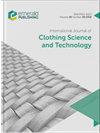使用包含可拉伸电容传感器的测量服制作个性化的男士基本身体块图案
IF 1
4区 工程技术
Q3 MATERIALS SCIENCE, TEXTILES
International Journal of Clothing Science and Technology
Pub Date : 2023-08-01
DOI:10.1108/ijcst-01-2023-0004
引用次数: 0
摘要
目的为了制作个性化的无袖男士基本鞋面服装图案,作者开发了一种测量服装,该服装可以测量必要的身体尺寸和角度。此外,作者还提出了一种利用获得的尺寸和角度制作个性化基本身体块图案的方法。设计/方法/方法作者决定了制作个性化服装所需的身体尺寸的位置。然后,作者将多个可拉伸电容传感器缝合到可拉伸T恤的相应位置。为了获得短长度传感器的尺寸,作者从实际身体长度和传感器电容之间的关系中间接获得了每个长度。在此之前,作者获得了五名参与者和一名假人的实际身体尺寸与传感器电容之间关系的线性近似方程。然后,作者使用测量服装和方程来获得另外六名参与者的身体尺寸。作者将获得的身体尺寸与实际身体尺寸进行了比较,以验证方程。作者根据获得的尺寸和角度,为11名参与者制作了个性化的无袖上衣图案。作者在穿着测试中验证了该方法,并将使用该方法设计的服装与传统设计的服装进行了比较。通过测量服装,作者获得了接近实际身体尺寸的身体尺寸。可以使用所获得的尺寸和角度来绘制个性化的基本鞋面服装的图案。与传统图案相比,个性化图案在肩点和侧颈点的位置以及肩线的方向上有显著差异,这与肩部形状有关(即方形、倾斜、向前或向后)。在穿着测试中,所有参与者都宣称,与肩部、颈部和腋下没有紧绷感的传统服装相比,个性化服装更适合他们的肩部。该方法与开发的测量服装相结合,对个性化服装的设计是有效的。独创性/价值本文提出了一种可能性,即不仅可以测量身体尺寸,还可以使用所提出的测量服装设计个性化的基本鞋面服装。所提出的测量服装将有助于在没有三维扫描仪或特殊技能的情况下高效制造个性化鞋面服装。本文章由计算机程序翻译,如有差异,请以英文原文为准。
Making individualized men's basic body block patterns with a measuring garment incorporating stretchable capacitance sensors
PurposeTo make individualized men's basic upper garment patterns without sleeves, the authors developed a measuring garment that measures necessary body dimensions and angles all together. Additionally, the authors proposed a method for making individualized basic body block patterns using the obtained dimensions and angles.Design/methodology/approachThe authors decided on the locations of the dimensions of the body required for making the individualized garments. The authors then sewed multiple stretchable capacitance sensors to corresponding locations on a stretchable T-shirt. To obtain the dimensions with sensors of short length, the authors indirectly obtained each length from the relationship between the actual body length and the capacitance of the sensor. Beforehand, the authors obtained linear-approximation equations for the relationship between actual body dimensions and the capacitance of sensors for five participants and a dummy. The authors then used the measuring garment and the equations to obtain the body dimensions of another six participants. The authors compared the obtained and actual body dimensions to verify the equations. The authors made individualized upper-garment patterns without sleeves and garments for the 11 participants with the obtained dimensions and angles. The authors verified the proposed method in wearing tests comparing garments designed using the proposed method with conventionally designed garments.FindingsUsing the measuring garment, the authors obtained body dimensions close to actual body dimensions. A pattern of the individualized basic upper garment using the obtained dimensions and angles could be drawn. Compared with the conventional patterns, the individualized patterns had notable differences in the locations of the shoulder point and side neck point and directions of the shoulder line, which relate to the shoulder shape (i.e. square, sloping, forward, or backward). In wearing tests, all participants declared that the individualized garment better fitted their shoulders than the conventional garment without tightness around the shoulders, neck, and armpits. The proposed method with the developed measuring garment was thus found to be effective in designing individualized garments.Originality/valueThis paper presents the possibility of not only measuring body dimensions but also designing individualized basic upper garments using the proposed measuring garment. The proposed measuring garment will assist the efficient manufacture of individualized upper garments without a three-dimensional scanner or special skills.
求助全文
通过发布文献求助,成功后即可免费获取论文全文。
去求助
来源期刊
CiteScore
2.40
自引率
8.30%
发文量
51
审稿时长
10 months
期刊介绍:
Addresses all aspects of the science and technology of clothing-objective measurement techniques, control of fibre and fabric, CAD systems, product testing, sewing, weaving and knitting, inspection systems, drape and finishing, etc. Academic and industrial research findings are published after a stringent review has taken place.

 求助内容:
求助内容: 应助结果提醒方式:
应助结果提醒方式:


